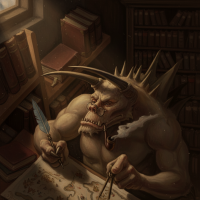
Wyvern
Wyvern
About
- Username
- Wyvern
- Joined
- Visits
- 3,153
- Last Active
- Roles
- Member
- Points
- 5,382
- Rank
- Cartographer
- Badges
- 24
-
Install Order?
Can't really do more than reiterate what Sue's said already re you and your mother's ongoing situation, and to hope things settle for you very soon.
With CC3+, I think we all feel for you too. Even a short spell away, and I find I've forgotten something critical... If time and circumstances allow, it might be worth checking-in on one or two of the live PF mapping sessions on YouTube - or checking them later as VOD - as Ralf usually goes through all the basics of setting up a new map, as well as whatever the session's about, for instance, which might help get you back in the swing of things a bit quicker.
-
A few final questions before I start adding text to my map
When mapping large areas like this, it's important to decide exactly how much detail is worth showing, and what the map is going to be used for (both of which go hand-in-hand).
A settlement will always require farmlands of some kind nearby, so any settlement means there will be such areas around it, even where the map doesn't show them. Then you can use the actual farmland areas to show those places that are particularly important farming areas - key places that the whole country/nation may rely upon, for instance. There, you wouldn't need to show any but the larger or most significant settlements (e.g. like the hamlet the party will be starting from!); all the other hamlets and villages can be assumed as present scattered among the farmland region without you needing to show each one.
For the non-cliff coastlines, I'd be inclined to soften the edges somewhat, maybe with a small Edge Fade effect, or reintroduce the "coastline" blue line for them. Softening the land edges on the cliff coasts wouldn't go amiss either, perhaps.
The aerial floating island looks interesting. Depending on how your floating lands like this work, you might also consider adding some crystal symbols (e.g. from one of the Dungeon sets, suitably enlarged of course!), or by using varicolor mountain symbols. With the settlement on top, it may be worth placing that directly onto the rocky mountain symbols, or with only a much smaller area of grassland fill texture behind the settlement image, then using just the mountain symbols (probably on their own, new Sheet) to cast a suitable drop-shadow. If the grass needs to definitely run right to the very edge of the stony platform, maybe make that more ragged, to closely match the symbol lines underneath indicating where that edge is.
-
Community Atlas - Forlorn Archipelago - Poncegraf Village - Church
For the Church, the pillar shadows could use some adjustment, as right now, they're passing over and through the walls, which is confusing.
On the upper floor (which might benefit from labelling as such), the stained-glass window patterns thrown on the floor need adjusting, so they cover only where the wooden flooring is - where they shine into the air beyond, there should be nothing.
Additionally, not all the windows should be showing these at all on either floor, only where the light will be shining directly through them, and that should match with where the floor shadows lie as well.
It might be helpful to add dashed or transparent lines on the lower floor image to indicate where the upper balconies are on the lower map view.
-
WIP tavern
While the size may seem wrong, by a strict comparison with some medieval European structures, this isn't for medieval Europe, it's for fantasy D&D, and is close to the scale size for this specific tavern as shown on Mike Schley's map of Saltmarsh in the Ghosts of Saltmarsh scenario book (Wizards of the Coast, 2019), assuming five-foot grid squares here. The appearance isn't quite the same as on that map, but this is an adaptation after all, and although there are a number of designs for the Wicker Goat Tavern online, I don't think there's an official D&D version, so some leeway is to be expected.
In the original adventure (The Sinister Secret of Saltmarsh, TSR's Module U1, from 1981), you were expected to create your own version of the town from scratch - there are a few guidelines for key points, such as Point 4: "Decide where the characters could stay when resting in the town between adventures (the best inn? the only inn?); draw up a tariff (list of expenditures) for their accommodation and food." But that's as close as we got to a description for the inn/tavern, which didn't even get a name back then!
That's not to say such points should just be ignored necessarily, and the heating and access points are useful considerations. However, if the final tavern is meant to fit to the size of the official Saltmarsh map, this is close enough to work for that.
-
Snowy lands
Looking at the symbol and terrain use here, I think these could be used to create an illusory city too, or a literal ghost town, perhaps with some additional colour overlay effects, and perhaps some transparency about the symbols (less sure about the latter point, however). Or indeed a city of glass.
-
WIP Ruins of Charn
One alternative you might try would be not using the RGB Matrix effect, but setting up a simple rectangular polygon that covers all the map on its own, new, sheet, setting the polygon to have a solid red colour, and then adding a Transparency effect to that sheet. If you move the sheet to be below the text, but above the rest of the map sheets, that might work. You'll probably need to keep adjusting the Transparency, and probably also the colour of the polygon (likely somewhere in the reds and oranges range) to get to something you're happy with. Not guaranteed to work ideally, but it should give you more control over the final colour of your text, at least.
-
Good sizes for fantasy cities etc
As Jim said, there's going to be a lot of personal preference involved here, heavily dependent on how you see your world setting developing, what types of civilizations exist in different places there, as well as how much time and effort you have available for designing and mapping it all.
Plus you're really asking two different, if related, questions - 1) the number of key buildings desirable for different types of settlement, and 2) what the appropriate size of different types of settlement can be for different types and numbers of special buildings.
The question of settlement sizes has come up on the Forum here before, and you might like to look over the comments on these two topics, both of which coincidentally came-up in late 2018:
Looking for advice on starting Village/Town/City size
There are also various systems for designing RPG settlements available online, some paid for (on sites such as DriveThru RPG), some not (such as blogs), as well as a number of random design systems, such as those on the Watabou site, although those provide primarily maps, rather than lists of the specific places you indicated as of interest.
Those should get you started at least, or perhaps help clarify what it is you want (or even don't want!) from such systems, from where you might feel more confident about creating your own settlement design system.
Good luck!
-
A random dungeon - Jon Roberts Style
Odd, as I was having the discussion about using random designed dungeons with another colleague online only yesterday!
I started with purely random designs back in the mid-late '70s, because I had no ideas to work from otherwise, having only just seen the original D&D booklets for the first time. As those who've followed my Atlas maps especially will be aware, I'm still a great fan of random design mechanics to stimulate ideas, or sometimes to better work out why some things aren't working well enough otherwise.
The Donjon system's a fun one, and there are plenty of other generators to try out if you've a mind to.
I've long found that the two elements - creator/occupier and layout plan - go hand-in-hand, and can be used to modify one another along the way. Thus a random idea might spark-off something still more interesting that follows a more logical pathway, until you reach a point of ambivalence, when more randomness can be brought in once more.
The sole comment I'd make about the map here so far is the secret doors are all far too obvious. Move the actual door to the nearest flat (room) wall junction, not at the end of a short passageway (add a second door for the one into/out of Room 9, as the approach could be from either side, so one flush door in the 9 wall, the other in the corridor wall to the west).
-
WIP: ICS Immaculate Radiance
Been a very long time since I did any spacecraft designs. General principles still apply though, remembering this is a self-contained, self-reliant unit, so essentially you need everything you'd have on a normal ship with a sizeable crew - they need to eat, sleep, stay clean (clothes and person; toilets as well), exercise, medical facilities, a means of controlling each system on the vessel, a means of communicating with other vessels and shore/planetary/orbital bases, a means of carrying out the vessel's primary and subsidiary functions, emergency escape facilities, emergency handling facilities (e.g. fire, flood, general damage control), a means of observing whatever is around them outside the vessel, and as you obviously already have, propulsive engines and fuel sources. This list is not exhaustive! And almost all this has to fit within the outer hull somehow.
Spherical and rounded hull shapes are a nightmare to design for. About 40 years ago, I drew out by hand a spherical free-moving spacecraft intended as a planetary defence vessel, one of a fleet, and that was horrendous, as (well, if you're me anyway) I had to keep checking how the outer circumference affected the internal space for different parts of every vertical level, and having to keep changing things because they'd no longer fit at the size intended, and so forth.
Unless there are strong reasons not to do so that make sense in-game, there's no physical necessity from our reality to have streamlined forms for spacecraft at all. Doesn't look so "Hollywood movie pretty", I grant you, but...
-
How long have you been using Campaign Cartographer?
I got the program in 2013, but did very little with it for a few years afterwards. I've only been especially active with it in more recent times, notably since about 2018, primarily in contributing items for the Community Atlas.
Using the program more frequently and regularly has certainly improved my grasp of what its capabilities are, something that's true for most people, I think. Finding the time, and sometimes the inspiration, to do that can be more of a challenge though!







